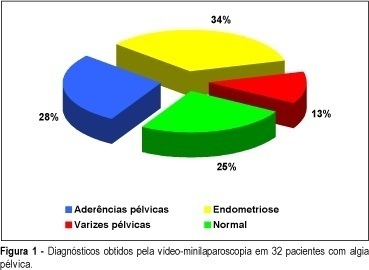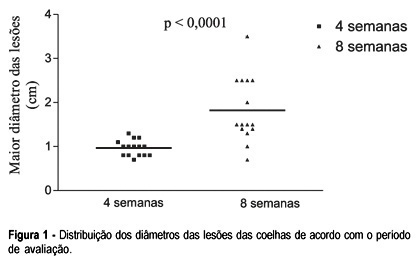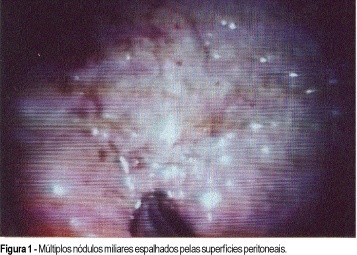Summary
Revista Brasileira de Ginecologia e Obstetrícia. 2000;22(2):95-100
DOI 10.1590/S0100-72032000000200006
SUMMARY Purpose: to study the usefulness of minilaparoscopy in diagnosing the cause of pelvic pain. Methods: women with pelvic pain were prospectively analyzed and underwent an office video-microlaparoscopy. We analyzed the data regarding procedure time, stay in the recovery room, acceptance of anesthesia, and morbidity. Results: the average procedure time of the office video-microlaparoscopy was 19 min, the average stay for recovery was 43 min, and the technical quality of the image was excellent or good in 100% of the selected patients. The following laparoscopic findings were reported: 34.4% endometriosis, 28.1% pelvic adhesion, 12.5% pelvic varices, and 25% normal. Based on Bordhal et al.'s¹ criteria, a low frequency of pain manifestation during local anesthesia (12.5%) and discomfort on pneumoperitoneum (46.9%) were noticed. It could also be observed that, according to Milki and Tazuke's² criteria, the tolerance to the method was excellent and good (96.9%). Twenty-four hours after the procedure the morbidity rate was in accordance with Chung et al.'s³ criteria, showing a high frequency of pain at the incision area (59.4%) and sleepiness (43.8%). Only 3.1% reported they felt pain during the procedure, which shows the acceptance of the method by the patients. Conclusions: the acceptance of anesthesia and of the surgical procedure and the low morbidity allow the use of minilaparoscopy as a very important method in investigating patients with pelvic pain.

Summary
Revista Brasileira de Ginecologia e Obstetrícia. 2004;26(9):741-743
DOI 10.1590/S0100-72032004000900011
Ectopic pregnancy is the implantation and development of the ovum outside the uterine cavity; it needs a quick diagnosis and an urgent treatment. The presence of the corpus luteum in the ovary that is contralateral to the ectopic pregnancy is presumptive evidence for ovum transmigration, which may be the cause of ectopic pregnancy. In 1994, a multinational clinical trial proved the superiority of levonorgestrel over the existing emergency contraceptive products. In the present study, we describe the case of a 27-year-old woman with ectopic pregnancy and a contralateral corpus luteum after use of hormonal emergency contraception (levonorgestrel), because of failure of the used contraception method (condom). The patient was treated with laparoscopic surgery that was successful.
Summary
Revista Brasileira de Ginecologia e Obstetrícia. 2004;26(9):715-719
DOI 10.1590/S0100-72032004000900007
PURPOSE: development of a new experimental model of endometriosis induction in rabbits evaluating its temporal evolution both macro-and microscopically. METHODS: thirty female rabbits were submitted to endometriosis induction through the fixation of a piece of the left uterine horn to the abdominal peritoneum. After four or eight weeks the viability of the lesions was verified by laparoscopy. The lesions were observed endoscopically. The implants were measured and histological analyses were made. The groups were compared for the presence of endometriotic lesion on laparoscopy, presence of adhesions, implant size and histological aspects. For statistical analyses we utilized Student's t and Mann-Whitney's tests, with a statistical significance of 5%. RESULTS: endometriotic lesions were identified in all cases submitted to laparoscopy after 4 weeks of induction, 64% of them cystic, and in 80% of the rabbits after eight weeks, 66% of which cystic. The adhesions were present in 71% of the rabbits after 4 weeks (none in the implants) and in 80% of the rabbits after 8 weeks (13% in the implants). The lesions were significantly larger after 8 weeks (p<0,0001). The histological analyses showed 100% of endometrial tissue in both groups. CONCLUSION: this experimental model showed that it is possible to simulate endometriosis in rabbits with a viable and simple technique, also allowing to record the characteristics and development of the implants macro-and microscopically. Although the histological aspects were similar, the lesions after eight weeks were larger than after four, making their manipulation easier.

Summary
Revista Brasileira de Ginecologia e Obstetrícia. 2000;22(8):525-528
DOI 10.1590/S0100-72032000000800009
Pelvic tuberculosis is an extrapulmonary form of tuberculosis with increasing incidence in the western world. Clinical and laboratory findings of this disease are often unspecific and mimic a variety of other disorders, including gynecologic malignant tumors. The authors report a case of a 53-year-old woman with pelvic tuberculosis and associated abdominal tuberculous peritonitis. Laboratory investigation included laparoscopy, CA-125 levels and tuberculin test, among others. Discussion on the clinicopathological aspects and diagnostic methods used to elucidate this case is presented.

Summary
Revista Brasileira de Ginecologia e Obstetrícia. 2001;23(10):627-631
DOI 10.1590/S0100-72032001001000003
Purpose: to analyze the pregnancy rates after laparoscopic and microsurgical treatment of hydrosalpinx. Methods: from July 1996 to May 1999 thirty-nine infertile patients with hydrosalpinx were treated according to a previously approved research protocol. They were randomly divided into two groups, according to the previously proposed surgical approach: laparoscopic or open microsurgical salpingostomy. To analyze the results, patients were stratified according to tubal damage, and pregnancy rates in both groups were determined for 24 months. Results: pregnancy rates in our series were 35.3 and 33.3% after laparoscopic and microsurgical salpingostomy, respectively. According to the severity of tubal damage, patients with mildly and moderately damaged tubes got pregnant in 66.7 and 21.7% of the cases, respectively. Cumulative pregnancy rates in one and two years were 25.0 and 34.4%, respectively. There was a single case of ectopic pregnancy, corresponding to 9.1% of all pregnancies. Conclusion: patients with mild and moderate lesions may be initially treated with surgery, and conception success is inversely proportional to the degree of tubal damage.
Summary
Revista Brasileira de Ginecologia e Obstetrícia. 2002;24(2):93-99
DOI 10.1590/S0100-72032002000200004
Purpose: to evaluate the correlation between the laparoscopic aspects and the stromal histologic findings of peritoneal endometriosis in order to understand the evolutive theory of endometriosis. Methods: sixty-seven women were submitted to laparoscopy for pelvic pain, infertility, ovarian tumor and other pathologies. A peritoneal biopsy was taken from the typical (puckered black) and atypical endometriotic implants. The different aspects of endometriosis were classified as follows: red lesions (Group V), black lesions (Group N) and white lesions (Group B). The histological sections were examined according to a standardized protocol. The histologic parameters used were: depth of the lesion, presence of hemosiderin, vascularization of the stroma and fibrotic tissue in stroma. Results: regarding lesion depth, there were significant differences between the groups. Red lesions were located consistently on the surface of the peritoneum (100%) and black lesions were superficial in 55.6%, intermediate in 38.9% and deep in 5.5%. White lesions were superficial in 28%, intermediate in 68% and deep in 4%. The presence of hemosiderin showed equivalent results in the 3 groups. The large stromal vascularization was present in the red lesions (60%), which a statistically significant difference compared to the other groups. Fibrotic tissue was present in 70.6% of the white lesions (group B), a fact that was significantly different when compared to groups V and N. Conclusion: the parameters analyzed in this study confirmed the importance of the evolutive theory of endometriosis.